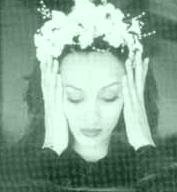

![]()
 Life
has indeed changed colours for Pamela Singh. From the lurid shades of
notoriety in the past where she shot to prominence with her involvement with
famous British MPs and newspaper editors, Pamela is today a woman who wants to
see life only in black and white. As a photographer, she chooses her subjects
with a deliberateness - people in need of compassion and understanding, people
whose spirit remains high despite life being hard on them. Her recent tour of
India, with her photo exhibition, showed a distinct desire to identify with the
women of India.
Life
has indeed changed colours for Pamela Singh. From the lurid shades of
notoriety in the past where she shot to prominence with her involvement with
famous British MPs and newspaper editors, Pamela is today a woman who wants to
see life only in black and white. As a photographer, she chooses her subjects
with a deliberateness - people in need of compassion and understanding, people
whose spirit remains high despite life being hard on them. Her recent tour of
India, with her photo exhibition, showed a distinct desire to identify with the
women of India.
Certainly, she wants to put as much distance between herself and her past as is possible. She concedes to interviews only on the condition that her past will not be raked up. Her transition has been her biggest triumph and she guards her victory fiercely.
And the fact that Andrew Neil, the former editor of the Sunday Times of London is bringing out a book detailing the torrid times he had with her back in 1989 does not faze her anymore.
Just seven years ago, people were calling her a modern-day Christine Keeler who almost brought down the British government, thanks to her dallying with men in power. Today, the only exposure she has in mind has to do with her camera.
In her new avatar as a trigger-happy journalist, Pamela’s trip to India was rewarding in more ways than one. She made peace with her mother, who had virtually disowned her after the scandal broke out, she earned a lot of goodwill with her exhibition in India and she left the country as a person who altered memories of herself in people’s minds.
 One
of the photographs by Pamela Singh: an obvious attempt to go beyond the obvious
One
of the photographs by Pamela Singh: an obvious attempt to go beyond the obvious
Her
recent exhibition at the Srishti Art Gallery in Jaipur had on display some
pretty impressive work. And Pamela is all smug about the new attention she is
drawing as someone who can make news on the other side of the lens as well. "It’s
been a lot of hard work," she says and adds, "I have found a new
platform in life." But then again, between the bouquets coming her way
have been some hard objects - many have accused her of copying the style of
photographer Steve McCurry, one of the most outstanding of contemporary lensmen,
whose assignments for the National Geographic have made him a famous name and
who has been one of the experts to take Pamela under his wing and train her.
Whatever the merits or otherwise of her work, there is one quality that stands out - there is nothing tentative about the pictures. Her sweeping eye has gathered images of Indian women from all walks of life. Pamela’s women are as diverse as the problems facing them today in a society that is in a state of flux.
Why did you become a photographer?
I didn’t choose photography. It chose me. In boarding school at Jaipur, I found myself fascinated by chemistry and ornithology. I didn’t have a camera, so I used to print other people’s negatives and then when I got my first camera I started documenting my life, putting myself in my pictures, using mirrors, self-timers because I was too shy to photograph others. At night I developed and printed the films in the darkroom, experimenting till I became good at it.
Tell us something about your photographs?
I wanted to show the ‘street’ as contemporary art, defying all the clichés of beautiful India. Most of my pictures are taken on the street. Some in homes. Life in India for a woman begins before dawn, goes way beyond dusk to midnight. I have shown different aspects of a woman’s life in India and also the lives of women in different professions and differing circumstances, without making any feminist statement.
- Times of India
"If the mountain doesn’t come down to man,’’ the old saying goes, ‘’then man must go to the mountain.’’
But as most wives and mothers will point out, man not only doesn’t like going to the mountain - he hardly ever goes to the doctor, the dentist or the counsellor.
This is why Bernard Denner, founder of the Men’s Awareness Network (MAN) in Australia, has decided to bring the mountain - or rather those beings who appear to live like mountain-gods, guarding their medical wisdom in lofty splendour - down to man. Through monthly meetings in the local pub, Denner is leading a grassroots approach to changing the way the average man in rural Australia thinks about his health.
"Men who religiously take their cars in for a service,’’ says Sri Lankan-born Ralph D’Silva, owner of one of Melbourne’s major Holden car sales and service centres, ‘’seldom recognise the fact that their own bodies also need care and maintenance.’’ Adds another Sri Lankan-born Australian, Doctor D.C. Jayasekera, ‘’As children, boys and girls visit their doctor about the same amount of times - but after they reach adulthood, men are not seen by their doctors until they get their first heart attack!’’.
Hard data from a 1985-87 Australian study confirms that the death rate for working aged men (between 25 and 64 years) is nearly double that of the age standardised rate for women. Except for deaths due to diseases of the reproductive system, men had a much higher death rate than women for all major causes of death. And men die, on average, six years earlier than women.
"One problem,’’ says Denner, who is not a doctor but a 47 year old former infantry soldier who fought in Vietnam in 1971,’’ is that men don’t have a forum in which to address their health concerns. What I’ve done is provide them with that forum.’’ Denner’s interest in health education for men began when he himself fell seriously ill. Having to undergo major abdominal surgery for bowel obstruction, he suddenly realised that he’d never been in hospital before and hadn’t a clue about his own body. When he recovered, he went for the first national conference on men’s health held in Melbourne in August 1995 - and was shocked by the statistics.
Returning to Castlemaine, his home town in the northeastern part of Australia’s state of Victoria, Denner began organising ‘Men’s Health Nights’. The first event attracted 280 men, mainly 40 to 50 year-olds. The programme began with the men filling out questionnaires indicating their main health concerns, but it also included presentations by some of the local doctors about men’s health problems. The audience, who shared the average man’s cluelessness about male health matters, found it scary to realise just how sick men can get if they don’t look after their bodies. "My aim,’’ claims Denner, ‘’is twofold - to make men aware of the health problems that can afflict them, and to make doctors and community health workers aware of men’s problems.’’
Among the subjects that most males wanted to know more about were the prostate, cholesterol and heart disease. And discussing prostates and coronaries over pretzels and beer not only helped the men to relate, as one man to another, to the doctors - it also helped the doctors themselves to become more ‘bloke-friendly’.
In addition to putting men in need of health advice with doctors in a position to advise them, Denner has roped in other health professionals - physiotherapists, dentists and counsellors. A bonus has been that these professionals who tended to practice in isolation, have been put in touch with each other, and so have come to know each other. Observed one Castlemaine doctor, ‘’Bernard has moulded us into a great team’’ - and this has benefited all concerned.
And men are turning up - initially off the street out of curiosity, but as word gets around, out of a genuine desire to learn.
"The idea,’’ says Denner, ‘’is to make men comfortable talking about the issues that affect them. The providers of health care and the men who need that care have got a chance to learn about each other and gain confidence in each other." In ancient China, doctors were not paid for providing ‘curative’, services when their patients fell ill: rather, they were paid a form of ‘retainer’ only if their patients remained well! Says Castlemaine farmer Brian Fahey, ‘’Perhaps in modern times, too, what we need is a greater emphasis on the role of the doctor as a health educator and one who helps his patients maintain good health.’’
Continue to Plus page 10 - Recognising problems : interview with former Minister Hameed
Return to the Plus contents page
![]()
| HOME PAGE | FRONT PAGE | EDITORIAL/OPINION | NEWS / COMMENT | BUSINESS
Please send your comments and suggestions on this web site to
info@suntimes.is.lk or to
webmaster@infolabs.is.lk